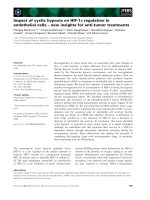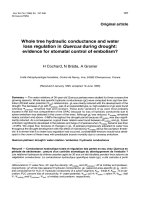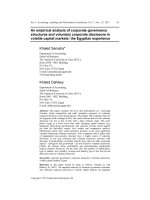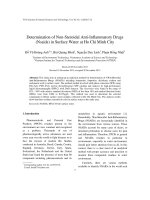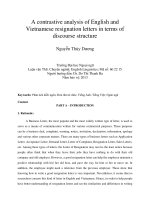Analysis and determination of cogging torque and unbalanced magnetic forces in permanent magnet spindle motors for hard disk drives
Bạn đang xem bản rút gọn của tài liệu. Xem và tải ngay bản đầy đủ của tài liệu tại đây (3.52 MB, 257 trang )
Title
ANALYSIS AND DETERMINATION OF
COGGING TORQUE AND UNBALANCED MAGNETIC
FORCES IN PERMANENT MAGNET SPINDLE MOTORS
FOR HARD DISK DRIVES
LI JIANGTAO
(M. Eng., Xi’an Jiaotong Univ., P. R. China)
A DISSERTATION SUBMITTED
FOR THE DEGREE OF DOCTOR OF PHILOSOPHY
DEPARTMENT OF ELECTRICAL AND COMPUTER ENGINEERING
NATIONAL UNIVERSITY OF SINGAPORE
2006
Acknowledgements
National University of Singapore I
Acknowledgements
I would like to express my most sincere and heartfelt gratitude to Dr. Z. J. Liu with
Data Storage Institute, Singapore and Prof. M. A. Jabbar with Electrical and Computer
Engineering, National University of Singapore, for their guidance, patience and
supports during the entire course of my Ph. D project. Without their judicious advices
and supports, my completion of the research work would not have been possible. It is
my utmost honor to be under their supervision.
I would like to extend my gratitude to Dr. C. Bi, Dr. Q. Jiang, and Dr. X. K. Gao, who
have kindly shared their knowledge and research experiences with me. My
appreciation also goes to all the staffs and students of Data Storage Institute, who have
helped me in one way or another. I also wish to thank all of my friends for their
encouragements and assistance to my studies in Singapore.
On a personal note, I am truly grateful to my parents and my wife, whose solid
supports have accompanied me all the time.
Table of Contents
National University of Singapore II
Table of Contents
Title I
Acknowledgements I
Table of Contents II
Summary VI
List of Tables IX
List of Figures XI
List of Symbols XIX
1 Introduction 1
1.1 Hard Disk Drives and Permanent Magnet Brushless DC Motors 1
1.2 Technical Problems Related to Spindle Motors in Hard Disk Drives 9
1.3 Performance Evaluations and Design Optimization of Spindle Motors 12
1.4 Organization of the Dissertation 14
2 Review on Computer Modeling and Analysis of PM Brushless DC Motors 17
2.1 Electromagnetic Field in PM Brushless DC Motors 17
2.2 Electromagnetic Forces in PM Brushless DC Motors 27
2.3 Effect of Calculation Error in Tangential Field Component on Calculation
Table of Contents
National University of Singapore III
of Electromagnetic Forces 30
2.4 Minimization of Cogging Torque and Unbalanced Magnetic Pull 34
3 Effect of Pole Transition over Slot Opening 38
3.1 Introduction 38
3.2 Pole Transition over Slot Model 40
3.2.1 Mathematical Model 41
3.2.2 Scalar Potential Distribution along Slot Opening 54
3.2.3 Flux Density Distribution in the Air Gap 56
3.2.4 Effect of Curvature 59
3.2.5 Tangential Force Waveform 62
3.3 Cogging Torque Calculation by Superposition Approach 64
3.3.1 General Procedure 64
3.3.2 Case Studies 67
3.4 Conclusion 74
4 Closed Form Solution of the Magnetic Field in PM Machines 75
4.1 Introduction 75
4.2 Scalar Potential Distribution on the Stator Surface in Slotted PM Motor76
4.3 Air Gap Field in Spindle Motors without LoadingError! Bookmark not
defined.
4.4 Armature Reaction Field 97
4.5 Back Electrical Motive Force 103
4.6 Magnetic Field in PM Motors with Rotor Eccentricity 104
Table of Contents
National University of Singapore IV
4.7 Conclusion 112
5 Closed Form Solution of Electromagnetic Forces in PM Machines 113
5.1 Introduction 113
5.2 Maxwell Stress Tensor Method 114
5.3 Cogging Torque 119
5.3.1 Influence of Pole-Arc to Pole-Pitch Ratio 125
5.3.2 Influence of Slot-Opening to Slot-Pitch Ratio 128
5.3.3 Effect of Rotor Eccentricity 130
5.4 Unbalanced Magnetic Pull 135
5.4.1 Influence of Pole-Arc to Pole-Pitch Ratio 138
5.4.2 Influence of Slot-Opening to Slot-Pitch Ratio 139
5.4.3 Effect of Rotor Eccentricity 139
5.5 Running Torque 145
5.6 Comparisons with Experimental Results 151
5.7 Conclusion 155
6 Minimization of Cogging Torque and UMP in PM Spindle Motors 156
6.1 Introduction 156
6.2 Constrained Optimization Problem 157
6.3 Powell’s Methods 159
6.4 Objective Functions and Design Variables 162
6.5 A Case Study 165
6.6 Cogging Torque Minimization 169
Table of Contents
National University of Singapore V
6.6.1 Peak Cogging Torque 169
6.6.2 Peak Cogging Torque to Running Torque Ratio 178
6.7 UMP Minimization 180
6.7.1 Average Radial Force 180
6.7.2 UMP Ripple to Average Radial Force Ratio 182
6.8 Conclusion 183
7 Combined Analytical and Numerical Approach for Design Optimization 184
7.1 Introduction 184
7.2 Response Surface Methodology 185
7.2.1 Concept of RSM 185
7.2.2 Limitation of RSM 191
7.3 Combined Analytical and Numerical Approach 197
7.4 Conclusion 205
8 Conclusions and Future Work 206
References 212
Appendix 228
List of Publications 231
Summary
National University of Singapore VI
Summary
With the rapid development of data storage technology, the permanent magnet spindle
motors in hard disk drives (HDDs) become smaller and smaller in size. In recent years,
following the successful commercial applications of 1 inch format micro-drives, the
smaller HDDs of 0.85 inch and 0.5~0.75 inch format begin to attract the attention due
to the fast development of wearable electronic devices such as pocket drives, mobile
phones and digital cameras with high storage capacities. In such high precision
applications, the design requirements for the electromagnetic forces are extremely
stringent. Electromagnetic forces such as the cogging torque and unbalanced magnetic
pull (UMP) generated in the permanent magnet spindles are of great concerns as they
may cause undesirable speed pulsation, mechanical vibration and acoustic noise which
in turn limit the recording density. A lot of efforts have been made to derive an
effective technique to suppress the cogging torque and UMP. However, to obtain the
accurate performance predictions speedily remains a challenging task in engineering
practice.
Numerical methods such as the finite element method (FEM) are widely adopted in the
Summary
National University of Singapore VII
study of field distributions and evaluation of the cogging torque and UMP. The
accuracy achieved is usually very high, but they are not suitable for design
optimization purposes if a large number of design parameters need to be investigated
for the special kind of PM motors used in hard disk drives. Analytical modeling as an
alternative has its own merits as it normally demands for less computer time and
therefore allows for fast analysis of PM motors of various magnetic structures. It also
provides deep insight into the underlying physical processes and is helpful in
establishing a relationship between the performance and the dominant design
parameters. Though, it is usually very hard to obtain the analytical solution of
instantaneous magnetic fields in electromagnetic devices, which in turn forms the basis
for accurate evaluation of electromagnetic forces. Several attempts have been made
previously by researchers to obtain analytical solutions of instantaneous magnetic
fields in permanent magnet motors. However, the existing analytical approaches, such
as those based on magnetic field energy or the estimation of the net tangential forces
acting on the slot walls, generally suffer lack of accuracy when predicting the
instantaneous magnetic fields and the cogging torque over a wide range of design
parameters. This is mainly due to the fact that the previous analytical approaches rely
on the radial component of the magnetic flux density in the air gap for PM motors with
slotted stator. However, detailed investigations show that the cogging torque prediction
relies heavily on the accuracy of the air gap flux density distribution, especially in
proximity of slot openings. Based on a comprehensive study of the mechanism of the
cogging torque in this dissertation, a new exact analytical solution of the boundary
Summary
National University of Singapore VIII
value problem associated with the instantaneous fields in PM motors is developed for
the detailed analysis of cogging torques. The electromagnetic forces in the radial
direction developed in PM motors are also derived and calculated based on the model.
The results are in good agreement with the numerical simulations using the finite
element method as shown by the comparisons in which a wide range of design
parameters, including the choices of pole number and slot number combinations, were
investigated. Due to the applications of the aerodynamic and fluid dynamic bearing
system, there exists the rotor eccentricity, and it affects both the amplitude and the
waveforms of the electromagnetic forces. Using the new analytical solution, both the
amplitude and the frequency spectrum can be calculated accurately when the rotor
eccentricity is present, which is not possible using the previously existing analytical
methods.
In order to obtain a global optimum, a large design space needs to be explored and a
large number of computations are required, which are usually not affordable if
numerical simulation tools are used to evaluate the target function. In this dissertation,
an optimization approach based on combined analytical solutions and numerical search
is devised to cope with the problem. The target functions are evaluated by analytical
solutions first to locate a sub-region where the global optimum may exist. Then, the
numerical simulation based Response Surface Methodology (RSM) is applied over the
sub-region to obtain the final optimum. The effectiveness of the approach is
demonstrated using design optimization case studies.
List of Tables
National University of Singapore IX
List of Tables
Table 1.1 The dimension of hard disk drives and their applications 4
Table 1.2 Dimensions of PM motors used for different formats of HDDs (in-hub
design) 5
Table 1.3 Rotation speeds of spindles and their applications 6
Table 3.1 Relationship between radial field motor and slot model 60
Table 3.2 Slot phase shift in an 8-pole 9-slot PM motor 66
Table 3.3 Parameters of an 8-pole 9-slot PM motor 68
Table 3.4 Parameters of an 8-pole 6-slot PM motor 71
Table 3.5 Parameters of a 12-pole 9-slot PM motor 72
Table 5.1 Coil arrangement in 8-pole 6-slot PM motors 146
Table 5.2 Coil arrangement in 8-pole 9-slot PM motors 147
Table 5.3 Coil arrangement in 8-pole 12-slot PM motors 148
Table 6.1 List of optimization variables 163
Table 6.2 Structure parameters of the studied PM motor 166
Table 6.3 One step in Powell’s method 168
Table 6.4 Comparison of the orginal design and the optimal design 169
Table 6.5 Determination of cogging torque period (p = 3) 170
List of Tables
National University of Singapore X
Table 6.6 Determination of cogging torque period (p = 4) 170
Table 7.1 Analysis of Variance 189
Table 7.2 Structure parameters of the studied PM motor 192
Table 7.3 Design parameters for testing RSM 193
Table 7.4 ANOVA 193
Table 7.5 Design Parameters 195
Table 7.6 ANOVA 195
Table 7.7 Control factors 199
Table 7.8 Levels for control factors 200
Table 7.9 Design setting matrix 201
Table 7.10 Runs of simulations and results 201
Table 7.12 ANOVA 202
Table 7.11 Coefficient of fitted response 203
Table 7.13 Comparison of the original and optimal design 204
List of Figures
National University of Singapore XI
List of Figures
Figure 1.1 Structure of a hard disk drive 2
Figure 1.2 Evolution of hard disk areal density [4] 3
Figure 1.3 One-inch micro-drive 4
Figure 1.4 A typical demagnetization curve of NdFeB permanent magnet 7
Figure 1.5 Cut-plane plot along the shaft axis of an exterior-rotor PM motor 8
Figure 1.6 Cross section view of an exterior-rotor PM motor 8
Figure 1.7 Schematic of run-outs 11
Figure 2.1 The slot model considering flux reduction 21
Figure 2.2 Schwarz-Christoffel transform 22
Figure 2.3 Simulated relative permeance function 23
Figure 2.4 Assumptions when summing up the net forces on slot walls 28
Figure 2.5 Effect of randomly distributed errors in flux density on cogging torque
calculation 32
Figure 2.6 Effect of randomly distributed errors in flux density on UMP calculation . 32
Figure 2.7 Comparison of flux density results from FEM and exisiting analytical
technique 34
Figure 3.1 Studied regions 41
Figure 3.2 Magnetization distribution along the x- direction 43
List of Figures
National University of Singapore XII
Figure 3.3 Schematic scalar potential distribution along the stator surface 46
Figure 3.4 Comparison of scalar potential along slot opening when N-S transition over
slot opening is present 55
Figure 3.5 Comparison of scalar potential along slot opening when S-N transition over
slot opening is present 56
Figure 3.6 Comparison of air gap flux density (s = 0) 57
Figure 3.7 Comparison of air gap flux density (s = 0.2) 57
Figure 3.8 Comparison of air gap flux density (s = 0.5) 58
Figure 3.9 Comparison of air gap flux density (s = 1) 58
Figure 3.10 Structure of radial field PM motors 59
Figure 3.11 Comparison of air gap flux density (
w
t = 0
o
) 60
Figure 3.12 Comparison of air gap flux density (
w
t = 1
o
) 61
Figure 3.13 Comparison of air gap flux density (
w
t = 2
o
) 61
Figure 3.14 Comparison of air gap flux density (
w
t = 4
o
) 62
Figure 3.15 Force waveform comparison (b
o
= 1.7 mm g = 0.25 mm h
m
= 2 mm) 63
Figure 3.16 Force waveform comparison (b
o
= 1 mm g = 0.25 mm h
m
= 1 mm) 63
Figure 3.17 Pole-slot relationship in 8-pole 9-slot PM dc motors 65
Figure 3.18 Superposition of force waveforms in 8-pole 9-slot PM motors 66
Figure 3.19 Superposition of force waveforms in 8-pole 6-slot PM motors 67
Figure 3.20 Superposition of cogging torque profiles in an 8-pole 9-slot motor 68
Figure 3.21 Mesh in the air gap of the studied motor 69
Figure 3.22 Cogging torque simulated by FEM using MST along different air gap
paths 69
Figure 3.23 Comparison of cogging torque results of virtual work and Maxwell stress
List of Figures
National University of Singapore XIII
tensor methods 70
Figure 3.24 Comparison of the results from FEM, superposition method and existing
analytical technique 70
Figure 3.25 Superposition of torque profiles in an 8-pole 6-slot PM motor 71
Figure 3.26 Comparisons of the results from FEM, superposition method and existing
analytical technique 72
Figure 3.27 Superposition of torque profiles in a 12-pole 9-slot PM motor 73
Figure 3.28 Comparisons of the results from FEM, superposition method and existing
analytical technique 73
Figure 4.1 Scalar potential along stator surface with rotor rotation of 5 degrees in an 8-
pole 9-slot PM motor 82
Figure 4.2 PM motor topology 83
Figure 4.3 Solution regions 83
Figure 4.4 Magnetization distribution in the tangential direction 84
Figure 4.5 Surface flux density distribution of a radially magnetized magnet sample
NP-8L ID-12P with back yoke [126] 85
Figure 4.6 Approximation of the real magnetization pattern in magnets 85
Figure 4.7 Flux lines in an 8-pole 6-slot PM motor 91
Figure 4.8 Comparison of air gap flux density in an 8-pole 6-slot PM motor (
α
p
= 1) 91
Figure 4.9 Error of (B
n
×
B
t
) comparisons in an 8-pole 6-slot PM motor (
α
p
= 1, rotor
position = 1 degree) 92
Figure 4.10 Flux lines in an 8-pole 9-slot PM motor 93
Figure 4.11 Comparison of air gap flux density in an 8-pole 9-slot PM motor (
α
p
= 1)
93
Figure 4.12 Error of (B
n
×B
t
) comparisons in an 8-pole 9-slot PM motor (
α
p
= 1, rotor
position = 1 degree) 94
List of Figures
National University of Singapore XIV
Figure 4.13 Flux lines in an 8-pole 12-slot PM motor 95
Figure 4.14 Comparison of air gap flux density in 8-pole 12-slot PM motor (
α
p
= 1). 95
Figure 4.15 Error of (B
n
×B
t
) comparisons in 8-pole 12-slot PM motor (
α
p
= 1, rotor
position = 1 degree) 96
Figure 4.16 Distribution of winding current in two adjacent slots and its equivalent
current distribution 97
Figure 4.17 Equivalent current distribution along the stator surface for a single coil 98
Figure 4.18 Solution region for armature reaction field 99
Figure 4.19 Connections of phase windings 101
Figure 4.20 Comparison of armature reaction field of the winding on a single tooth 102
Figure 4.21 Comparison of armature reaction field of the winding on adjacent teeth102
Figure 4.22 Comparison of back EMF waveforms 104
Figure 4.23 Schematics of rotor eccentricity 105
Figure 4.24 The coordinates to study the effece of rotor eccentricity 106
Figure 4.25 New orthogonal coordinates 108
Figure 4.26 Comparison of radial flux density in the air gap in an 8-pole 9-slot PM
motor with 40% rotor eccentricity 111
Figure 4.27 Comparison of tangential flux density in the air gap in an 8-pole 9-slot PM
motor with 40% rotor eccentricity 112
Figure 5.1 Cogging torque comparisons in an 8-pole 6-slot PM motor (
α
p
= 1) 122
Figure 5.2 Cogging torque comparisons in an 8-pole 6-slot PM motor (
α
p
= 0.9) 122
Figure 5.3 Cogging torque comparisons in an 8-pole 9-slot PM motor (
α
p
= 1) 123
Figure 5.4 Cogging torque comparisons in an 8-pole 9-slot PM motor (
α
p
= 0.9) 124
Figure 5.5 Cogging torque comparisons in an 8-pole 12-slot PM motor (
α
p
= 1) 124
List of Figures
National University of Singapore XV
Figure 5.6 Cogging torque comparisons in an 8-pole 12-slot PM motor (
α
p
= 0.9) 125
Figure 5.7 Peak cogging torque value vs. pole-arc to pole-pitch ratio in an 8-pole 6-slot
PM motor with slot opening of 12 degrees 126
Figure 5.8 Peak cogging torque value vs. pole-arc to pole-pitch ratio in an 8-pole 9-slot
PM motor with slot opening of 10 degrees 127
Figure 5.9 Peak cogging torque value vs. pole-arc to pole-pitch ratio in an 8-pole 12-
slot PM motor when slot opening angle is 4 degrees 127
Figure 5.10 Peak cogging torque value vs. slot-opening to slot-pitch ratio in an 8-pole
6-slot PM motor when the pole-arc to pole-pitch ratio equals to 1 128
Figure 5.11 Peak cogging torque value vs. slot-opening to slot-pitch ratio in an 8-pole
9-slot PM motor when the pole-arc to pole-pitch ratio equals to 1 129
Figure 5.12 Peak cogging torque value vs. slot-opening to slot-pitch ratio in an 8-pole
12-slot PM motor when the pole-arc to pole-pitch ratio equals to 1 129
Figure 5.13 Cogging torque profile in an 8-pole 9-slot PM motor with static rotor
eccentricity of 10% 131
Figure 5.14 Frequency spectrum of cogging torque in an 8-pole 9-slot PM motor in
absence of rotor eccentricity 132
Figure 5.15 Frequency spectrum of cogging torque in an 8-pole 9-slot PM motor with
static rotor eccentricity of 10% 132
Figure 5.16 Cogging torque profiles in an 8-pole 9-slot PM motor with rotor
eccentricity of 10%, with and without whirling speed of 100 % 133
Figure 5.17 Frequency spectrum of cogging torque in an 8-pole 9-slot PM motor with
rotor eccentricity of 10% and whirling speed of 100% 133
Figure 5.18 Cogging torque in an 8-pole 12-slot PM motor with and without rotor
eccentricity 135
Figure 5.19 Maxwell stress tensors in different coordinates 136
Figure 5.20 The x- and y- components of radial force in an 8-pole 9-slot PM motor
when the pole-arc to pole-pitch ratio is 1 137
Figure 5.21 Locus of the UMP in an 8-pole 9-slot PM motor when the pole-arc to pole-
List of Figures
National University of Singapore XVI
pitch ratio is 1 137
Figure 5.22 Radial force vs. pole-arc to pole-pitch ratio in an 8-pole 9-slot PM motor
when slot opening angle is 10 degrees 138
Figure 5.23 Radial force vs. slot-opening to slot-pitch ratio in an 8-pole 9-slot PM
motor when the pole-arc to pole-pitch ratio is 1 139
Figure 5.24 UMP in an 8-pole 9-slot PM motor with 10% static rotor eccentricity 140
Figure 5.25 Frequency spectrum of the radial force in an 8-pole 9-slot PM motor
without rotor eccentricity 141
Figure 5.26 Frequency spectrum of the radial force in an 8-pole 9-slot PM motor with
10% static rotor eccentricity 141
Figure 5.27 UMP profiles in an 8-pole 9-slot PM motor with rotor eccentricity of 10%
and whirling speed of 100% 142
Figure 5.28 Frequency spectrum of the radial force in an 8-pole 9-slot PM motor with
rotor eccentricity of 10% and whirling speed of 100% 142
Figure 5.29 UMP in an 8-pole 12-slot PM motor with 10% static rotor eccentricity. 143
Figure 5.30 Frequency spectrum of the radial force in an 8-pole 12-slot PM motor with
static rotor eccentricity of 10% 144
Figure 5.31 UMP in an 8-pole 12-slot PM motor with 10% rotor eccentricity and 100%
whirling speed 144
Figure 5.32 Structure and winding layout of 8-pole 6-slot PM motors 146
Figure 5.33 Structure and winding layout of 8-pole 9-slot PM motors 147
Figure 5.34 Structure and winding layout of 8-pole 12-slot PM motors 148
Figure 5.35 Current flowing in the phase windings 149
Figure 5.36 Ideal current scheme 149
Figure 5.37 Measurement of phase current waveforms 150
Figure 5.38 Eexperimental setup for PM brushless dc motors 151
List of Figures
National University of Singapore XVII
Figure 5.39 Measured back EMF waveform 152
Figure 5.40 Calculated back EMF waveform 152
Figure 5.41 Measured running torque 153
Figure 5.42 Calculated running torque using ideal current waveform 154
Figure 5.43 Measured phase current waveform 154
Figure 5.44 Calculated running torque using real current waveform 155
Figure 6.1 Flow chart of the Powell’s method 161
Figure 6.2 Cogging torque vs. pole-slot combinations (p = 3) 171
Figure 6.3 Cogging torque vs. pole-slot combinations (p = 4) 171
Figure 6.4 Three-dimensional plot of peak value of cogging torque vs. pole-arc to pole-
pitch ratio and slot-opening to slot-pitch ratio in an 8-pole 6-slot PM motor (analytical)
173
Figure 6.5 Three-dimensional plot of peak value of cogging torque vs. pole-arc to pole-
pitch ratio and slot-opening to slot-pitch ratio in an 8-pole 6-slot PM motor (numerical)
173
Figure 6.6 Contour plot of peak value of cogging torque vs. pole-arc to pole-pitch ratio
and slot-opening to slot-pitch ratio in an 8-pole 6-slot PM motor 174
Figure 6.7 Three-dimensional plot of peak value of cogging torque vs. pole-arc to pole-
pitch ratio and slot-opening to slot-pitch ratio in an 8-pole 9-slot PM motor 175
Figure 6.8 Three-dimensional plot of peak value of cogging torque vs. pole-arc to pole-
pitch ratio and slot-opening to slot-pitch ratio in an 8-pole 12-slot PM motor
(analytical) 176
Figure 6.9 Three-dimensional plot of peak value of cogging torque vs. pole-arc to pole-
pitch ratio and slot-opening to slot-pitch ratio in an 8-pole 12-slot PM motor
(numerical) 176
Figure 6.10 Three-dimensional plot of peak cogging torque vs. air gap length and
magnet thickness in an 8-pole 9-slot PM motor (
α
p
= 1,
α
o
= 10
o
) 177
Figure 6.11 Three-dimensional plot of peak cogging torque vs. air gap length and
List of Figures
National University of Singapore XVIII
magnet thickness in an 8-pole 12-slot PM motor (
α
p
= 1,
α
o
= 8
o
) 178
Figure 6.12 Three-dimensional plot of running torque vs. pole-arc topole-pitch ratio
and slot-opening to slot-pitch ratio in an 8-pole 12-slot PM motor 179
Figure 6.13 Three-dimensional plot of the cogging torque to running torque ratio vs.
pole-arc to pole-pitch ratio and slot-opening to slot-pitch ratio in an 8-pole 6-slot PM
motor 179
Figure 6.14 Three-dimensional plot of average radial force vs. pole-arc to pole-pitch
ratio and slot-opening to slot-pitch ratio in an 8-pole 9-slot PM motor 181
Figure 6.15 Three-dimensional plot of UMP vs. air gap length and magnet thickness in
an 8-pole 9-slot PM motor (α
p
= 1, α
o
= 10
o
) 181
Figure 6.16 Three-dimensional plot of radial force ripple vs. pole-arc to pole-pitch
ratio and slot-opening to slot-pitch ratio in an 8-pole 9-slot PM motor 182
Figure 7.1 CCD for 2 variables 188
Figure 7.2 CCD for 3 variables 189
Figure 7.3 Response surface of cogging torque over {
α
t
∈ [32 deg, 35 deg]
α
p
∈ [0.5,
1]} 192
Figure 7.4 Fitted response surface over {
α
t
∈ [32 deg, 35 deg]
α
p
∈ [0.5, 1]} 194
Figure 7.5 True response surface over {
α
t
∈ [32 deg, 35 deg]
α
p
∈ [0.75, 0.95]} 196
Figure 7.6 Fitted Response Surface over {
α
t
∈ [32 deg, 35 deg]
α
p
∈ [0.75, 0.95]}. 196
Figure 7.7 Flow chart of the combined analytical and numerical approach 198
Figure 7.8 Parameters of tooth structure 198
Figure 7.9 Contour plot of cogging torque to running torque ratio vs. pole-arc to pole-
pitch ratio and slot-opening to slot-pitch ratio in the 8-pole 6-slot PM motor 200
Figure 7.10 The fitted response vs. x
1
and x
2
203
Figure 7.11 Cogging torque comparison of the original and optimal design 204
List of Symbols
National University of Singapore XIX
List of Symbols
α
o
Slot opening angle
α
p
Pole-arc to pole-pitch ratio of magnet
α
s
Slot-opening to slot-pitch ratio
α
t
Slot pitch
ε
Rotor eccentricity
μ
0
Permeability of air
μ
r
Relative permeability of the material
τ
m
Magnet pole arc
τ
p
Pole pitch
τ
s
Slot pitch
φ
Scalar magnetic potential
ω
Angular speed
B Magnetic flux density
B
n
, B
t
Normal and tangential flux density
b
o
Slot opening length
B
r
Remenance of magnet
List of Symbols
National University of Singapore XX
e Back-EMF
F
r
Radial force
F
x
, F
y
x- and y- components of UMP
g Air gap length
H Magnetic field intensity
h
m
Magnet thickness
H
tt
Tooth tip height
I Current
J Current density
M Magnetization of magnet
p Pole pairs
Q
s
Slot number
R
m
Inner radius of magnet
R
r
Inner radius of rotor yoke
R
s
Outer radius of stator yoke
s
Magnet pole transition shift to slot
opening
T
c
Cogging torque
T
r
Running torque
W
tb
Tooth body width
Chapter 1 Introduction
National University of Singapore 1
1 Introduction
1.1 Hard Disk Drives and Permanent Magnet
Brushless DC Motors
Due to the rapid development of computer technologies and microelectronics, the
demand for higher processing speed, larger memory size and data storage capacity in a
computer system has increased steadily over these years. With the need of mass data
storage, the hard disk drive (HDD) has become an essential component of a computer
system. Figure 1.1 shows the structure of a hard disk drive. The platters are installed
on the spindle motor which rotates the platters at a constant speed. The magnetic head
is installed at the end of the suspension. The suspension is controlled by an actuator to
locate the magnetic head at different data tracks and to write data along a certain track.
Chapter 1 Introduction
National University of Singapore 2
Figure 1.1 Structure of a hard disk drive
The most noticeable historic trend in high capacity and high performance hard disk
drives has been size reduction, capacity increase, and cost reduction. In terms of the
storage capacity, reliability and other characteristics, hard disk drives have been
improved steadily along with other key components in PCs, such as the central
processing unit (CPU). The storage capacity of hard disk drives is measured by the
areal density [1], which is defined as the number of bits that can be stored in a unit area.
It is usually expressed in bits per square inch (BPSI). The areal density of hard disk
platters continues to increase at an amazing pace in recent years. In 2005, Seagate has
achieved a milestone with an areal density of 100 Gbits/in
2
[2]. Modern disks are now
able to pack as much as 400 Gigabits of data onto a single 3.5" platter [3].
Chapter 1 Introduction
National University of Singapore 3
Figure 1.2 Evolution of hard disk areal density [4]
Figure 1.2 shows the progress of areal density over the past several decades. The key
HDD head technology developments are also indicated. It is observed that the areal
density increased by almost ten folds every ten years.
On the other hand, the form factors of hard disk drives are taking a downsizing trend.
The 5.25" drives have now all but disappeared from the mainstream PC market, with
3.5" drives dominating the desktop and server segments. In the mobile world, 2.5"
drives are the standard with smaller sizes becoming more prevalent. So far, following
the successful commercial applications of 1 inch format micro-drives (as shown in
Figure 1.3), the smaller format hard disk drives of 0.85 inch and 0.5~0.75 inch are
emerging.
Chapter 1 Introduction
National University of Singapore 4
Figure 1.3 One-inch micro-drive
Table 1.1 The dimension of hard disk drives and their applications
Platter Diameter Typical Form Factor Application
5.12 5.25"
Oldest PCs, used in servers through the
mid-1990s and some retail drives in
the mid-to-late 1990s. Now obsolete
3.74 3.5"
Standard platter size for the most
common hard disk drives used in PCs
3.0 3.5"
High-end 10,000 RPM drives
2.5 2.5", 3.5"
Laptop drives (2.5" form factor),
15,000 RPM drives (3.5" form factor)
1.8 PC Card (PCMCIA)
PC Card (PCMCIA) drives for laptops
1.3 PC Card (PCMCIA)
Originally used on hand-held PCs (no
longer made)
1.0 Compact Flash
Digital cameras, hand-held PCs and
other consumer electronic devices
Table 1.1 summaries the most typical platter sizes used in PCs. The most commonly
used form factors are also listed.

